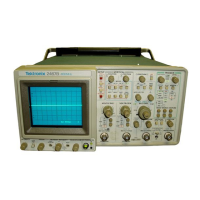Specification—2465B/2467B Service
Table 1-8
Environmental Requirements
Characteristics
Temperature
Operating
Nonoperating (Storage)
Altitude
Operating
Nonoperating (Storage)
Humidity
Operating and Storage
Vibration (operating)
Not Rack Mounted
Rack Mounted
Shock (operating and nonoperating)
Not Rack Mounted
Rack Mounted
Transit Drop (not in shipping package)
Bench Handling (cabinet on and cabinet off)
Performance Requirements
Environmmental requirements qualify the electrical and mechanical
specifications. When not rack mounted, the instrument meets the
environmental requirements of MIL-T-28800C for Type III, Class 3,
Style C equipment, with the humidity and temperature requirements
defined in paragraphs 3.9.2.2, 3.9.2.3, and 3.9.2.4. Rack mounting
changes the temperature, vibration, and shock capabilities. The
rack mounted instruments meet or exceed the requirements of
MIL-T-28800C with respect to Type III, Class 5, Style C equipment
with the rack-mounting rear-support kit installed. Rack mounted
instruments will be capable of meeting or exceeding the
requirements of Tektronix Standard 062-2853-00, class 5.
-15°Cto + 55°C.
For a rack mounted instrument, ambient temperature should be
measured at the instrument's air inlet. Fan exhaust temperature
should not exceed +65°C.
-62°C to + 85°C.
To 15,000 feet. Maximum operating temperature decreases
1
°C for
each 1000 feet above 5000 feet.
To 50,000 feet.
Stored at 95% relative humidity for five cycles (120 hours) from
30 °C to 60
°C,
with operational performance checks at 30 "C and
55°C.
15 minutes along each of three axes at a total displacement of
0.025 inch p-p (4 g at 55 Hz), with frequency varied from 10 Hz to
55 Hz in one minute sweeps. Hold 10 minutes at each major
resonance or, if none exists, hold 10 minutes at 55 Hz (75 minutes
total test time).
Change displacement to 0.015 inch p-p (2.3 g at 55 Hz).
50 g, half sine, 11 ms duration, three shocks on each face, for a
total of 18 shocks.
30 g.
8-inch drop on each corner and each face (MIL-T-28800C, para.
4.5.5.4.3).
MIL-STD-810C, Method 516.2, Procedure V (MIL-T-28800C, para.
4.5.5.4.3).
1-23

